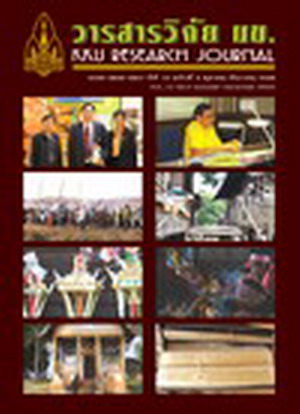Effect of cadmium and selenium on hepatic xenobiotic metabolizing enzymes of hamsters (Thai)
Main Article Content
Abstract
This research aimed to study the effect of cadmium and selenium on hepatic xenobiotic metabolizing enzymes of hamsters. Male hepatic Phase I and Phase II xenobiotic metabolizing enzymes systems seem to be more susceptible to cadmium toxicity than those of the female. Components of Phase I xenobiotic metabolizing enzymes including cytochrome P450 (Cyt P450), cytochrome b5 (Cyt b5) were decreased in every group of cadmium-treated animals of both genders. In contrast, cytochrome c reductase (Cyt c reductase) activities of male hamsters treated with 2.5 and 5 mg/kg cadmium were increased. Phase II enzyme, glutathione-S-transferase (GST) activities of male animals which received 1.0 and 2.5 mg/kg cadmium were lower than their controls. However, only GST of female animals receiving 5 mg/kg cadmium was decreased. Cadmium increased the activity of γ-glutamyl transpeptidase (GGT), which is the marker for liver cell damage, in both genders. Hepatic cadmium levels were clearly found to be lower in animals receiving selenium and cadmium when compared to the cadmium-treated group. Low dose cadmium increased levels of Cyt P450, Cyt b5 and Cyt c reductase in males, whereas there were no changes in Cyt P450 and Cyt b5 levels, but decreased Cyt c reductase activity in females. Males receiving selenium alone showed a tendency for increased levels of hepatic Cyt P450, Cyt b5 and Cyt c reductase activity, but did not reach statistical significance. Selenium increased levels of Cyt P450 and Cyt b5 but did not change Cyt c reductase activity in females. When compared to control or cadmium-treated animals, co-administration of selenium and cadmium increased Cyt P450 in both genders, whereas Cyt b5 levels increased in females and did not change in males. The Cyt c reductase activity was decreased in males but increased in females receiving a combination of these two elements. Low doses of cadmium or selenium or combination of cadmium with selenium did not change GST activity in males. In contrast, females receiving selenium alone or selenium in combination with cadmium showed higher GST activity than the control group. GGT activity increased in both males and females receiving selenium plus cadmium. In conclusion, cadmium given either in low or high doses was very toxic to hamsters. It disturbed the xenobiotic metabolizing enzymes in males more than in females. Administration of selenium can attenuate cadmium toxicity by decreasing the hepatic accumulation of cadmium and changing the metabolizing enzymes of hamsters. Abstract ประชากรในบางพนทื้ ี่ เชน กร


